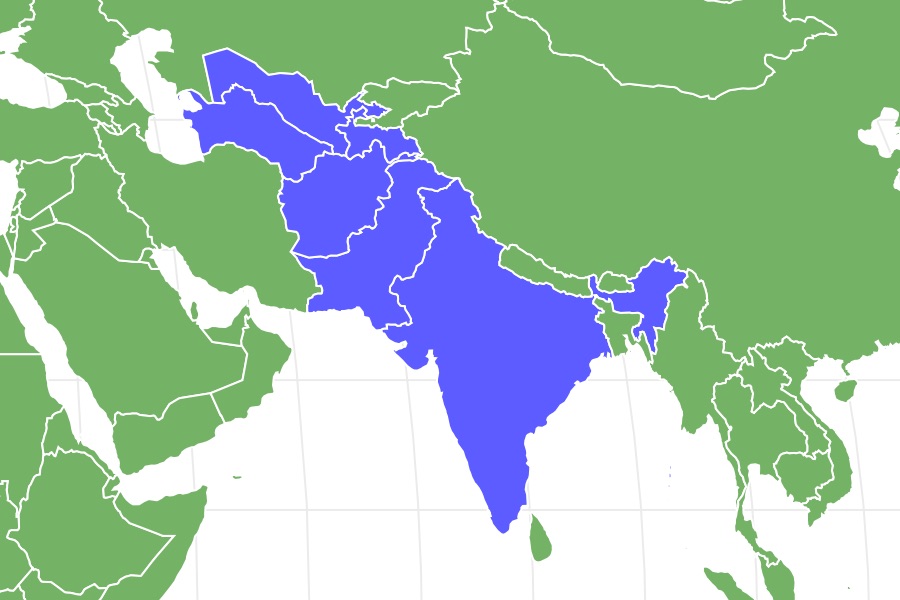Markhor
Capra falconeri
The markhor drools a foamy substance after chewing its cud, which the local people use for extracting snake poison.
Advertisement
Markhor Scientific Classification
- Kingdom
- Animalia
- Phylum
- Chordata
- Class
- Mammalia
- Order
- Artiodactyla
- Family
- Bovidae
- Genus
- Capra
- Scientific Name
- Capra falconeri
Read our Complete Guide to Classification of Animals.
Markhor Conservation Status
Markhor Facts
- Main Prey
- Grasses, leaves, herbs
- Fun Fact
- The markhor drools a foamy substance after chewing its cud, which the local people use for extracting snake poison.
- Distinctive Feature
- Long winter hair and large, spiralled horns
- Habitat
- Sparsely wooded cliff-sides
- Predators
- Snow leopards, wolves, lynx, humans
View all of the Markhor images!
The markhor is the national animal of Pakistan.
The markhor, a species of large, wild goat, is native to western and central Asia’s mountains and high-altitude monsoon forests. Also called the screw-horned goat or Shakhawat, it was considered to be the most challenging animal to hunt in British India due to the danger that pursuing them at high altitudes brought.
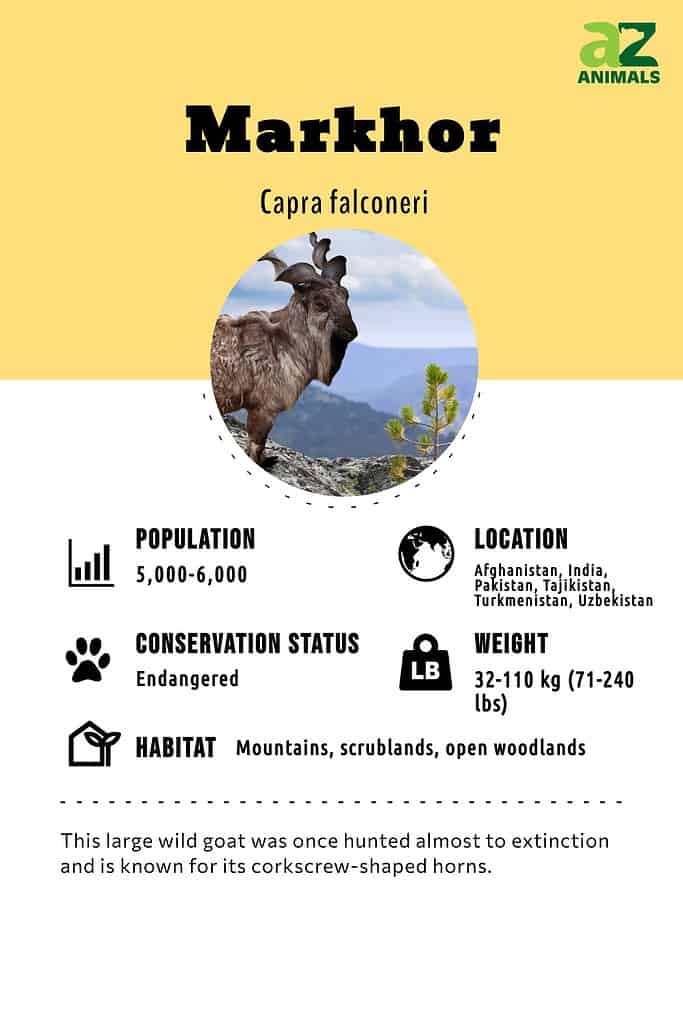
5 Fascinating Facts About the Markhor!
- The markhor is Pakistan’s national animal.
- It was featured in the World Wide Fund for Nature Conservation Coin Collection in 1976, along with 72 other animals.
- Afghan puppet shows known as buz-baz use markhor marionettes.
- It has been on the livery of Pakistan’s flag carrier, Pakistan International Airlines, since 2018.
- Allahyar and the Legend of Markhor, a Pakistani computer-animated film, mentions the markhor.

The markhor is the national animal of Pakistan.
©iStock.com/Derek Brumby
Scientific Name
Capra falconeri is the scientific name of the markhor. Capra refers to a genus of mammals, specifically the genus of goats, and includes wild goats and ibexes. Falconeri refers to the species.
Markhor is a combination of Persian and Pashto words: “Mar” translates as snake and “khor” means eater. According to the region’s folklore, the markhor’s horns give it special abilities including being an eater or killer of snakes. The local population uses the foamy substance that results from the markhor chewing its cud to extract snake poison.
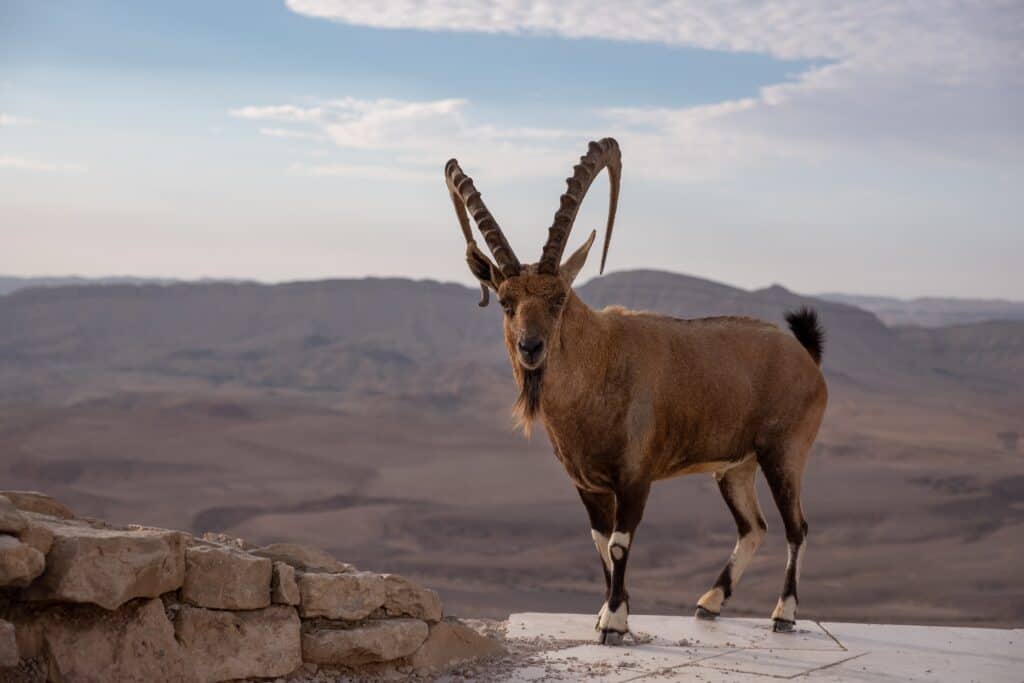
The ibex belongs to the same genus,
Capra, as the markhor.
©A.Pushkin/Shutterstock.com
Types of Markhor
Due to the corkscrew shape of its horns, the markhor is known as a screw horn or screw-horned goat in Pakistan. All varieties of markhor goats have horns that are long, flaring, typically curled, and appear snake-like. However, it is possible for their horns to differ even within the same herd on a particular mountain range.
There are a few subspecies of markhor goats that are recognized by the IUCN and can be identified by the shape of their horns:
- Astor (Capra falconeri falconeri): Also known as Pir Panjal, this subspecies has large, flat and wide-branching horns that flare in different directions. It is found in Afghanistan, Pakistan, and India.
- Bukharan (Capra falconeri heptneri): Their twisted horns have three half-turns, and they have habitats in Afghanistan, Tajikistan, Turkmenistan, and Uzbekistan. Other common names for this subspecies are Tajik, Turkmenian, or Heptner’s markhor.
- Kabul (Capra falconeri megaceros): Also called the straight-horned markhor, as its spiral-shaped horns stand up straight, this subspecies is present in Afghanistan and Pakistan.
Some believe there are two other possible subspecies, but these are disputed:
- Kashmir (Capra falconeri cashmiriensis): This markhor has heavy, flat horns with flaring, loose corkscrew-style twisting, showing two half-turns. Astor is often synonymous with Kashmir.
- Suleiman (Capra falconeri jerdoni): They have horns with tight corkscrew-style twisting resulting in four half-turns.
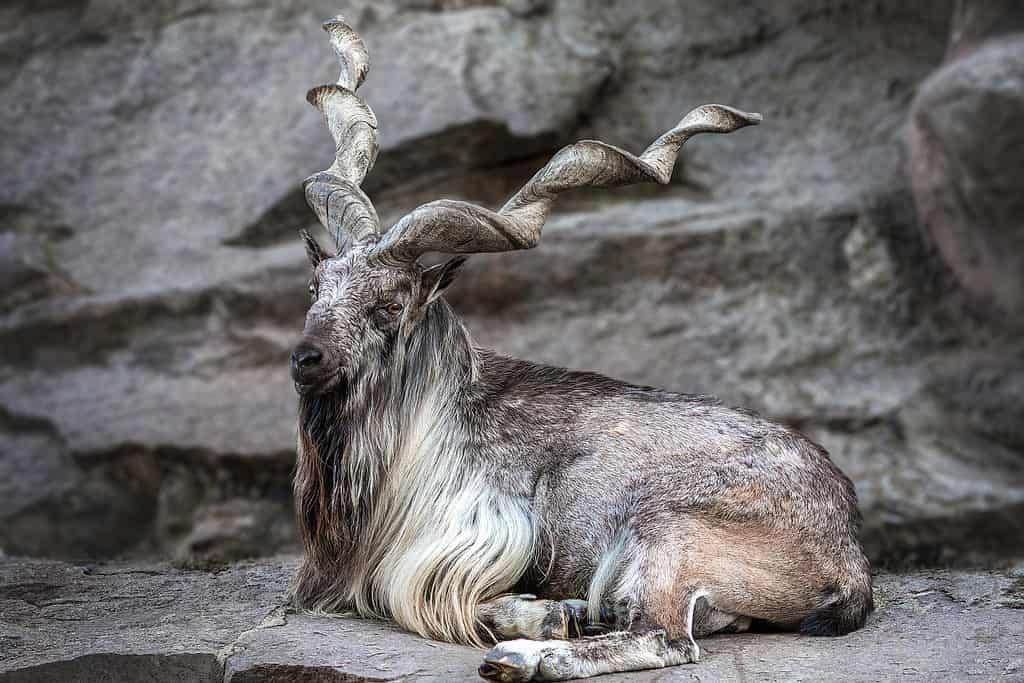
All varieties of markhor goats have long, curled horns.
©Armensl/Shutterstock.com
Evolution and History
In the 19th century, naturalist Charles Darwin theorized that it was through crossbreeding the markhor with wild goats that the modern goat was developed. Scientists have continued to conduct research into the relationship between the markhor and other goats, with some believing the markhor could be the ancestor of many different domesticated goats such as the Angora goat, Ladakh and Tibet’s Changthangi goat, Sicily’s Girgentana goat, and Ireland’s Bilberry goat.
The markhor is the largest goat in its family and the only one that has adapted to living at altitudes of 4,000–12,000 feet in northern Pakistan’s mountains. The genetic adaptation of wider hooves assists the markhor to keep its balance climbing and navigating uneven and steep terrain.
During the time of the British Raj’s reign in Pakistan, from 1858 to 1947, and for decades after, markhor were popular targets for hunters, especially those who sought the challenge of capturing high-altitude game. Overhunting led to the species nearly becoming extinct by 1990. In an effort to prevent extinction, Pakistan’s government banned hunting markhors in 1991. In Kashmir, trophy hunting has been organized yearly since 2000, with the highest bidder receiving the license to hunt a markhor and proceeds going toward conservation and local communities.
Appearance
Markhors are animals that have grizzled, long hair which may come in brown, grey-black, white, tan, or any combination thereof. It is short and smooth in summer and longer and thicker in winter. Most notable however are its unique horns which usually grow up to 5 feet long in mature males. Their lower legs are usually black and white. They are 65-115 cm (26-45 in) in height at the shoulder, 132-186 cm (52-73 in) in length, and 32-110 kg (71-243 lbs). Only the Siberian ibex exceeds its weight and length, but they have the highest shoulder length in the Capra genus.
The species is sexually dimorphic, meaning the males and females do not look the same. Males have longer hair on the chin, throat, chest, and shanks, while females have shorter, redder hair, a short black beard, and no mane. Both have horns, but while the males’ can grow up to 160cm (63 in), the females’ only grow up to 25 cm (10 in). The males also have a strong odor which is stronger than that of the domestic goat.

The markhor has grizzled, long hair in different shades.
©Igor Boldyrev/Shutterstock.com
Behavior
The males are loners and females gather into herds of nine. As a crepuscular diurnal species, they are active during the day and mostly in the early morning and late afternoon. They are excellent at climbing and jumping on rocky, high altitudes. When threatened, they have an alarm call that sounds like a domestic goat’s bleating. The males remain in the woods during the summer, while the females climb the highest terrain. They descend to lower altitudes in the winter to avoid extreme cold. They forage 8-12 hours a day except for the middle of the day when they stop to rest and chew their cud.

The markhor is excellent at climbing and jumping on rocky, high altitudes.
©BearFotos/Shutterstock.com
Habitat
The markhor’s habitat varies depending on its subspecies, but they generally live in the scrublands, open woodlands, and mountains of central Asia, Karkoram, and the Himalayas. Their range of scattered herds includes Turkmenistan, Uzbekistan, Tajikistan, Afghanistan, Pakistan, and northern India.
Astor or Pir Panjal lives in the Indian region of Kashmir, northern Pakistan, and eastern Afghanistan at altitudes of up to 3,600 m (11,800 ft). Bukharan, Tajik, Turkmenian, or Heptner’s markhor live in Tajikistan, Pakistan, Turkmenistan, and Uzbekistan, and possibly parts of Afghanistan, up to 13,000 feet above sea level. Kabul and Suleiman live in Afghanistan and Pakistan, and Kashmir live in Afghanistan.

The markhor’s habitat includes the Himalayas.
©bodrumsurf/Shutterstock.com
Diet
It competes with domestic goats over food. This is due to the greater numbers of herds of domestic goats, which drive the wild goats away from food sources. Their typical diet is grass, leaves, and shoots. During spring and summer, they graze and during winter they browse trees.
Predators and Threats
Snow leopards, Himalayan wolves, Eurasian lynx, and brown bears are predators of the markhor. The golden eagle also preys on juvenile markhor. Feral dogs were reported in 2022 to have been behind the deaths of 392 markhors over the past 15 years in the Chitral Gol National Park.
Hunters and poachers are also a threat to markhor, pursuing them in India for both food and due to the desire for their unique horns, which they value as trophies. They are commonly hunted along with the Himalayan ibex and in Afghanistan, it is traditional to hunt them in Nuristan and Laghman. Foreign trophy hunters and powerful Pakistanis overhunted and poached markhor so much that by the 1960-70s they were endangered. It was in the 1970s that Pakistan passed conservation legislation. However, hunting still goes on in spite of its being illegal in all three countries.
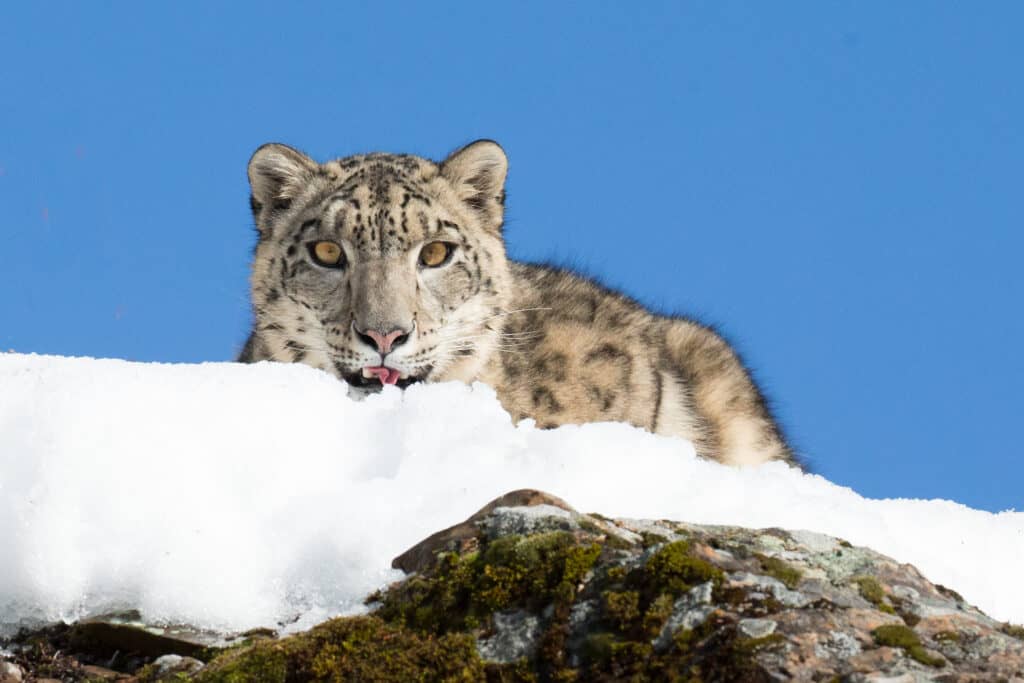
The
snow leopard
is one of the markhor’s natural predators.
©Warren Metcalf/Shutterstock.com
Reproduction, Babies, and Lifespan
Male markhors fight for the attention of females by locking horns and then twisting and pushing against the other male. Mating season is in the winter when males start rutting, and both sexes reach maturity at 18-30 months.
As a mammal, markhor mothers give birth to live young. After a gestation period of 135-170 days, they give birth to 1-2 kids. The kids are weaned at 5-6 months. Markhor can be expected to live around 10-13 years in the wild and up to 19 years in captivity. A markhor’s age can be determined by counting the rings on its horns.

Markhor kids are weaned around 5-6 months.
©Tarakanbix/Shutterstock.com
Population
The largest population of Astor or Kashmir markhor is currently found in Chitral National Park in Pakistan, where they now exceed 1,000 in number. The population increased by about 20% during the past decade. Data from 2022 estimates the number of markhors at 5,000-6,000. Its conservation status is Near Threatened since 2015 according to the IUCN Red List.
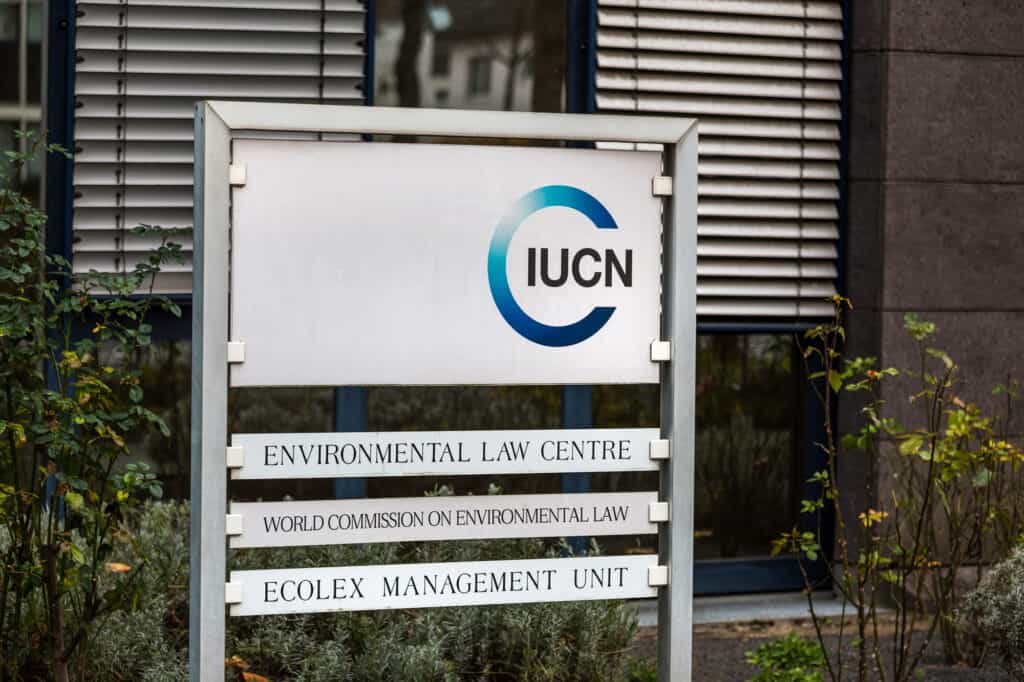
The IUCN’s Red List classifies the markhor as Near Threatened.
©Tobias Arhelger/Shutterstock.com
Markhor in Zoos
These animals are commonly housed with other wild goats. For example, in the Bronx Zoo, they live with a herd of Himalayan Tahr. Zoos in several countries are common international conservation sites for markhor, while parks serve the same purpose on the local level.

The markhor is housed with the Himalayan Tahr at the Bronx Zoo.
©Japan’s Fireworks/Shutterstock.com
Markhor FAQs (Frequently Asked Questions)
What is a markhor?
A markhor is a species of large, wild goat in central and western Asia.
What does a markhor eat?
Markhors eat grass, leaves, and shoots on the ground and in trees, bushes, and other shrubbery.
How far can a markhor jump?
Markhor can jump at least 8 feet high.
Is the markhor endangered?
It has been endangered due to poaching. Currently, there are less than 2,500 left in the wild. The IUCN Red List of Endangered Species considers it to be near-threatened, meaning it could reach Vulnerable, Endangered, or Critically Endangered in the near future. This change from its past “endangered” status was due to conservation efforts. It is a fully protected (Schedule I) species in India, under Jammu and Kashmir’s Wildlife (Protection) Act of 1978.
Where do markhor live?
Markhor can be found in the scrublands, open woodlands, and mountains of Afghanistan, Pakistan, and India.
What are the markhor's special abilities?
Markhor can jump in rocky terrain to reach higher altitudes and climb trees.
What kingdom do markhors belong to?
Markhors belong to the kingdom Animalia.
What class do markhors belong to?
Markhors belong to the class Mammalia.
What phylum to markhors belong to?
Markhors belong to the phylum Chordata.
What family do Markhors belong to?
Markhors belong to the family Bovidae.
What order do Markhors belong to?
Markhors belong to the order Artiodactyla.
What genus do markhors belong to?
Markhors belong to the genus Capra.
What type of covering do markhors have?
Markhors are covered in hair.
What are some predators of markhors?
Predators of markhors include wolves, snow leopards, and lynx.
What are some distinguishing features of markhors?
Markhors have long winter hair and large, spiraled horns.
How many babies do markhors have?
The average number of babies a markhor has is 1.
What is an interesting fact about markhors?
The markhor drools a foamy substance after chewing its cud, which the local people use for extracting snake poison.
What is the scientific name for the markhor?
The scientific name for the markhor is Capra falconeri.
What is the lifespan of a markhor?
Markhors can live for 10 to 13 years in the wild, and up to 19 years in captivity.
How fast is a markhor?
A markhor can travel at speeds of up to 10 miles per hour.
Thank you for reading! Have some feedback for us? Contact the AZ Animals editorial team.
Sources
- David Burnie, Dorling Kindersley (2011) Animal, The Definitive Visual Guide To The World's Wildlife
- Tom Jackson, Lorenz Books (2007) The World Encyclopedia Of Animals
- David Burnie, Kingfisher (2011) The Kingfisher Animal Encyclopedia
- Richard Mackay, University of California Press (2009) The Atlas Of Endangered Species
- David Burnie, Dorling Kindersley (2008) Illustrated Encyclopedia Of Animals
- Dorling Kindersley (2006) Dorling Kindersley Encyclopedia Of Animals
- David W. Macdonald, Oxford University Press (2010) The Encyclopedia Of Mammals
- Wikipedia, Available here: https://en.wikipedia.org/wiki/Markhor
- Facts and Details, Available here: http://factsanddetails.com/central-asia/Central_Asian_Topics/sub8_8i/entry-4557.html
- WCS Pakistan, Available here: https://pakistan.wcs.org/Wildlife/Markhor#:~:text=Threats%20include%20intense%20hunting%20pressure,is%20largely%20within%20Pakistan's%20borders.
- Animal Corner, Available here: https://animalcorner.org/animals/markhor/#:~:text=Markhor%20Reproduction&text=Fights%20involve%20horn%20locking%20and,young%20(kids)%20are%20born.
- Los Angeles Zoo & Botanical Gardens , Available here: https://www.lazoo.org/animals/mammals/tadjik-markhor/
- New England Zoo, Available here: https://www.zoonewengland.org/stone-zoo/our-animals/mammals/markhor/

